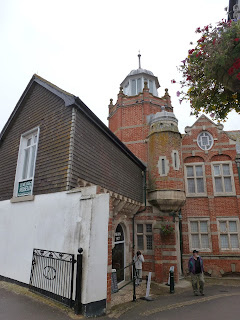 Oh, Wednesday night with no more Bake-Off or Doctor Foster - see what you've done to me. I have to watch renovation programmes instead. Which is, like, literally watching paint dry.
Oh, Wednesday night with no more Bake-Off or Doctor Foster - see what you've done to me. I have to watch renovation programmes instead. Which is, like, literally watching paint dry.This new series highlights the work of The Landmark Trust, who do up dilapidated buildings of one-time historical significance and then rent them out as holiday lets - at significant prices.
This week they were in Lyme Regis, Lancaster and Hougoumont. The latter because the Landmark Trust will travel as far as Belgium if a property on the site of the Battle of Waterloo is involved. They send over their furniture designer John, who is the sort of bloke that has a towel rail collection (because "You never know when someone might break one by putting a wet towel on it") and wanders around warehouses saying things like "Haven't we got a box of Pugin handles?" In Belgium, John gets cross with the excessive and ugly lighting his counterpart has installed. Said counterpart has a wonderful line in Gallic shrugs to respond to John's withering comments. "What blind man chose this paint colour?" Shrug. "I feel like I haven't been heard." Another shrug. Maybe that's because you insist on speaking English to him rather than French.
In Lancaster, they are restoring the gilded ceiling of the Music Room, and creating a marbled effect on the walls using beer and swan feather brushes. The painter's cheeks end up speckled in gold leaf. He plainly loves his job.
In Lyme Regis, they are working on Belmont, a "maritime villa" owned by Eleanor Coade from 1784 and lived in from 1968 by John Fowles, the author of The French Lieutenant's Woman. Eleanor Coade invented Coade stone, an artificial weatherproof stone used for various statues across London and for the embellishment of Regency properties. Coade ran a factory in Lambeth roughly on the site of St Thomas's Hospital by the Thames, opposite the future Houses of Parliament. It's extraordinary to learn about a successful business woman in the Georgian era.
Needless to say, Belmont is covered in Coade stone, like a great big advert for the family trade. And it is soon, after the demolition of an extension, restored to its former glory by the Landmark Trust. (Although not as soon as the television programme would have you believe, it transpires, once you delve into local newspaper articles online.) Now open for business, it's fully booked until 2017. But somehow I don't think they would welcome our five year old's sticky fingers.
Just as well, then, that I have a friend who lives eight miles away. We went to visit her this summer and spent a rainy day in Lyme Regis. It was sunny up on the hill in Devon where we were staying - perfect beach weather. But Lyme down in the bay in Dorset was drenched in soggy drizzle. It was full of depressed families having arguments, wistfully remembering the summers of yore, when it didn't tip it down for the whole of August. Not even the happy (I won't say clappy) Christians playing Duck, Duck, Goose and making custard pies on the beach could cheer the kids up.
 |
| Arguing families on the beach |
Unaware of Eleanor Coade at the time, we resorted to following the footsteps of another famous Lyme lady, Mary Anning. She collected fossils, discovered the ichthyosaur and is the subject of Tracy Chevalier's novel Remarkable Creatures. There are two fossil museums in Lyme Regis, only one of which is officially recognised and only one of which contains Lego. But if you want to see bad plastic dinosaurs and mouldy taxidermy, by all means visit the other. Neither museum occupied our girl's attention for long, so soon it was back onto the Cobb to watch the crabby families crabbing and screaming for ice cream. Nonetheless, our daughter was inspired enough to write a story over lunch in a cafe, the only word of which she could spell correctly was "chips".
 |
| Fossil Museum |
 |
| Another Fossil Museum |
 |
| Fossil beach |
 |
| Walking The Cobb |
 |
| Crabbing and crabby |

No comments:
Post a Comment